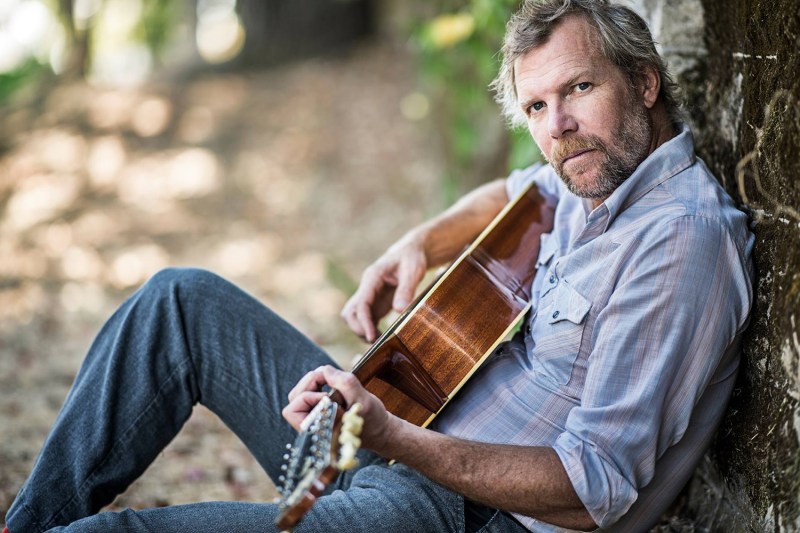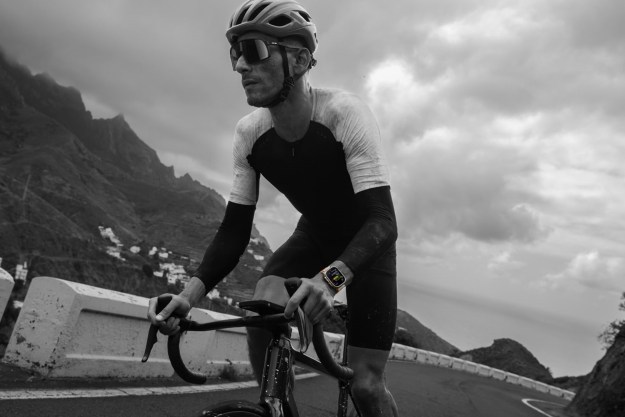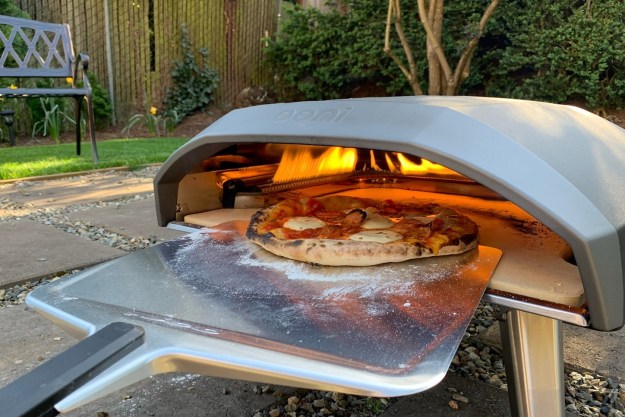
Four years ago, rocker Tim Bluhm was living out the second act of a musician biopic. He’d walked away from his acclaimed band The Mother Hips, as well as his beachside home and his marriage of eight years, and was living out of a van while roaming the southwestern desert, trying to learn how to fly.
Tim had always been a thrill-seeker: rock climbing, backcountry skiing, surfing some of California’s most dangerous breaks, and most recently, speedflying (like paragliding, but way more intense).
Whether by luck or by sheer moxie, Tim had never once had an accident. But in late 2015, his number came up. His glider began rocking violently, and as Tim struggled to regain control, his altitude plummeted. He saw the ground rising up to meet him and knew he was going to land badly. The only question was how bad.
Tim hit the ground at 35 miles per hour, slamming feet first into a pile of felled trees. His ankle snapped in half. His pelvis was shattered. His foot was nearly severed from his leg. And yes, he was alive and awake the whole time, feeling all of it. He remembers looking down at his crushed body and thinking, “You’re a guy with one foot now. That was sudden.”
At this point, the movie version of Tim’s life would cut to him waking up in the hospital. In real life, Tim had to lie there waiting for the ambulance to arrive, then endure the excruciating discomfort of being cut out of his clothes and gear, lifted and strapped to a backboard, loaded into the truck, and rushed to the emergency room. Blasted with ketamine, he slipped into a hazy sleep, fairly certain that he’d already died and arrived at the next plane. In his words, “it wasn’t all that great.”
My music has always been pretty introspective. I definitely see now that life is more fragile and less permanent than I thought, and maybe that makes me crave more strongly the immortality that a great song can have.
But Tim didn’t die. Instead, he spent the next six months in three different hospitals, undergoing over 20 surgeries on his ankle, as well as a few on his pelvis, while being blasted with powerful IV antibiotics to combat a bone infection that had set in. During his waking moments, he did his best to soothe the anxieties of family, friends, and bandmates and kept his fingers crossed that the crowdfunding campaign they’d started would save him from drowning in medical debt.
Again, the movie version would end with Tim getting up and striding powerfully back to the concert stage or into the surf break. Instead, he spent several more months living with his parents, battling an addiction to the opioid pain medications he’d been given, and trying not to think too much about the mountain of credit card debt awaiting him.
It would be a low moment for anyone. For Tim, who played alongside the likes of Johnny Cash, Lucinda Williams, and the last living members of the Grateful Dead; ran a production studio that hosted indie-rock luminaries like Los Lobos and Josh Ritter; founded the Hipnic music festival in Big Sur; and played to sold-out crowds all over the world for over 20 years, the drop from his old life to his new life was as steep as his drop out of the sky. He felt imprisoned in his own body, unable to roll over in bed or read a book, much less walk or play music. It seemed his life would now be spent watching the world march on without him from behind a veil of the darkest despair he’d ever known.
Strangely, giving in to his circumstances proved to be the way toward recovery. As he grew used to his new condition, his brain began to break out of the shell of despair. The old sparks of curiosity, adventure, and creativity began to revive. He found himself writing songs again. Over time, as his crash wounds healed and his physical strength was restored, he awakened to what he describes as “a new, if somewhat unclear, outlook on what it means to face my fears.” That said, Tim’s story hardly fits into the neat and tidy “inspirational” packaging of other near-death experiences. “I actually found entirely new categories of fears to be faced, ones that had never occurred to me. In that sense, the experience was positive.”
Some might call this cynical. We call it real.
The songs Tim wrote over the months of rehabilitation have been collected into a brand-new album, Sorta Surviving. Released on March 29, Sorta Surviving was recorded at Johnny Cash’s infamous Cash Cabin (just outside of Nashville) and produced by Dave Schools of Widespread Panic. The album, which includes covers of classics by Johnny Cash, Merle Haggard, and The Everly Brothers, exchanges the soulful psych-rock of The Mother Hips for a gritty but contemplative country vibe.
After getting a listen to Sorta Surviving, we were lucky enough to chat with Tim about the insights he gained from the road back from death to life.
The Manual: What would you say is the common thread among your passions (writing music, performing, outdoor adventure)?
Tim Bluhm: I like how outdoor activities such as surfing or skiing are so much different than music. It’s that contrast that creates a balanced-feeling life for me. Being a musician involves travel more than anything else, and usually not the “fun” kind of travel. When I’m done working, I love nothing more than getting outside and feeling my lungs and heart pump, feeling the wind on my face, and feeling the solitude of the natural world. Something that music and outdoor pursuits do have in common is that neither is overtly competitive. I’ve always been drawn to things where the challenge is pretty much internal, a test of oneself.
TM: When did you “awake” from your accident, and what were your thoughts/feelings at that moment?
TB: When I awoke, I was in a hospital bed. The first thing I did was look down to see if I had a foot or not. To my surprise, my left foot was there at the end of my leg. It looked terrible, really bad, and I couldn’t wiggle my toes or anything, but there it was. I was immensely relieved at that moment, having absolutely no idea how much trouble I would endure trying to keep my foot and leg healthy over the ensuing two years.
TM: As an outdoorsman, you must have thought that your days of adventure could be over, perhaps even your ability to play and perform music. What was it like to confront the potential loss of things you loved so much?
TB: I never really thought that I wouldn’t be able to play guitar or sing, though I was forced to take a year off from touring because my ankle developed a bone infection, I was never sure how things would end up. Ultimately I ended up with a fixed ankle, wherein a large titanium “nail” extends down my leg into my talus. I have zero ankle mobility. The thought of not being able to walk or run, hike or ski or surf was the cause of deep despair for me, but I knew enough to know that I needed to figure out a way to be grateful for the things I hadn’t lost. With hard work, I have been able to resume some of those activities fully, and days go by now when I don’t even think about it.
TM: What’s it like to identify not just as a musician and outdoorsman now, but as a near-death-experience survivor? How does that change your brand, for better or worse?
TB: I have become more cautious in my physical activities, and I think I have some form of post-traumatic stress that mostly manifests through me overthinking small risks that I’m facing. I’ll get freaked out by something I wouldn’t have thought twice about before my accident, and when I finally do it, I can see that my worry was unnecessary and exaggerated.
As far as affecting my brand, I think that chapter of traumatic experience sits pretty well in my overall story. Going through life and being forced to submit to the changes age brings feels like a survival story in itself, and I’m sure most guys feel the same way. My accident seemed to dramatize that feeling.
TM: How has survival changed your music?
TB: My music has always been pretty introspective. I definitely see now that life is more fragile and less permanent than I thought, and maybe that makes me crave more strongly the immortality that a great song can have. But on the other hand, I can see that most of what we all do on this planet doesn’t really matter, so why take any ambition so seriously?
TM: What state is your physical health in now? Do you still face any physical limitations and if so, how do you deal with them?
TB: I feel like I’m pretty much back to normal now. It’s been just over four years since the crash, and two years since my last surgery. As I said, I’ve had to work pretty hard to regain my fitness but once I identified the activities I could still do, I went pretty hard. I can’t run at all anymore, not even across the street, but I can walk pretty far and fast. I have a carbon fiber brace that I wear when I’m hiking, backpacking or working on my property, and it really helps my foot to not hurt. Biking and skiing are both pretty pain-free, at least until I hit bumps going too fast.
TM: Have any cool opportunities arisen since your accident that wouldn’t have happened otherwise?
TB: I was helped by an adaptive sports program called Achieve Tahoe and I’ve been able to help them raise money, and I’ll continue to do that. Once in a while, someone will reach out to me with questions about ankle fusions they are undergoing. It’s very helpful to hear directly from someone who’s been there. I kind of knew Bill Walton through the Grateful Dead world and he was extremely generous with his advice and knowledge.
TM: For men who are facing the potential loss of a dream, whether it’s from a physical accident or some other life circumstance, what advice can you offer?
TB: I am definitely an advocate for never giving up on a dream. But it is always possible to come up with another parallel dream and pursue that. There are countless worthwhile goals out there and your heart will let you know when you’ve discovered a good one.
Click here to listen to Tim Bluhm’s new record Sorta Surviving. To hear more of Tim’s story in his own words, definitely check out his essay on Talkhouse.


